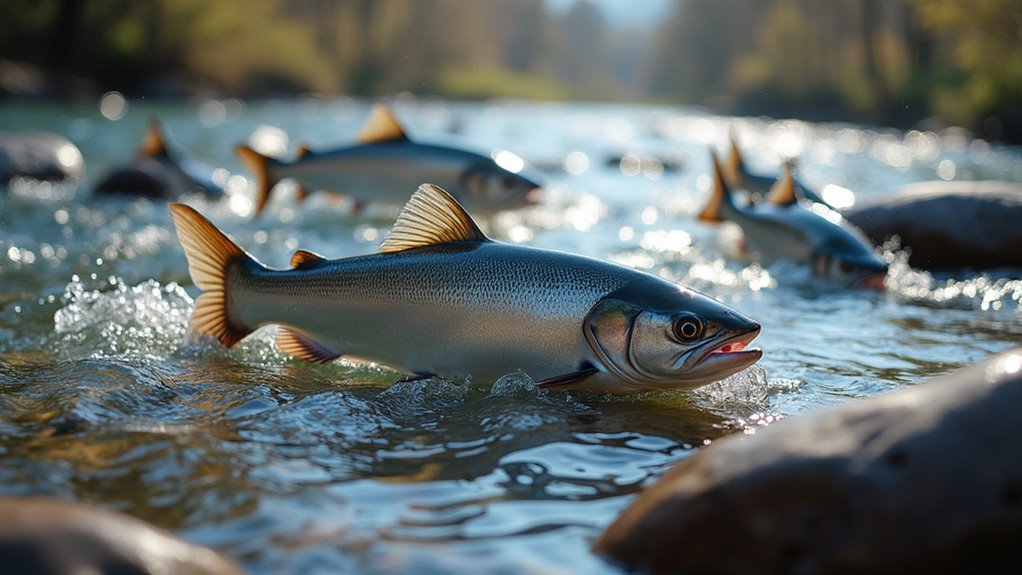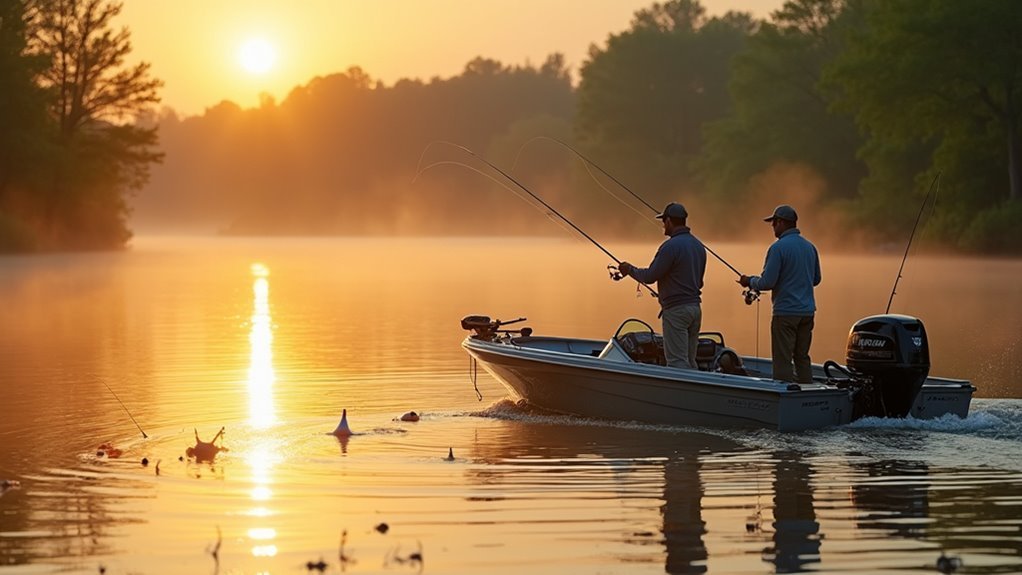To master American shad fishing, you’ll need to understand their spring spawning migration patterns and use the right gear—typically a 7-foot light to medium action rod with 6-12 pound test line. Fish from banks using drift or bobber techniques near current breaks, or track schools by boat. Try bright-colored shad darts, small spoons, and jigs in chartreuse or green. These aggressive fighters don’t feed during migration but will strike from irritation. The thrill awaits beyond the next cast.
Understanding American Shad Migration Patterns

Where do these remarkable fish journey throughout the year? American shad spend most of their lives in the ocean, swimming along coastal waters before answering nature’s call to spawn.
These anadromous travelers make their way into freshwater rivers when conditions are just right – typically springtime, though timing varies by region.
Nature’s clock prompts these remarkable fish to enter freshwater on a perfect spring day, with southern shad arriving before their northern cousins.
In warmer southern waters, you’ll see shad runs beginning earlier, while northern migrations might start later.
I think what’s fascinating is how millions navigate through major systems like the Columbia River, passing landmarks like Bonneville Dam.
They’re not feeding during these journeys, perhaps making them more likely to strike at lures out of aggravation rather than hunger.
Essential Tackle and Gear for Shad Fishing
The right gear can make all the difference when you’re targeting American shad. You don’t need expensive equipment, but selecting the proper tackle will improve your success rate noticeably.
Light to medium action rods are ideal – I think 7-footers offer the perfect balance for handling these fighters. Match them with a quality reel that can handle 6-12 pound test line.
| Gear Type | River Size | Weight | Notes |
|---|---|---|---|
| Rod | Small Rivers | Light | 6-7 ft length |
| Rod | Large Rivers | Medium | 7-8 ft length |
| Line | Low Current | 6-8 lb | More sensitivity |
| Line | Strong Current | 10-12 lb | Added strength |
Perhaps the most overlooked item is a good net. Shad have soft mouths, and you’ll lose many at the bank without one.
Bank Fishing Techniques for American Shad
Three prime bank fishing techniques make American shad accessible to anglers without boats.
First, drift fishing with a light-action rod (6-12 pound test) and positioning yourself near rocks or jetties where shad tend to congregate. You’ll want to cast slightly upstream and let your lure drift naturally with the current.
Second, try using split shots or slinkies to get your lures deeper, especially during midday when shad might be holding in deeper water. Just enough weight to maintain contact with the bottom usually works best.
Lastly, I think bobber fishing with shad darts can be particularly effective, perhaps during early morning or evening hours when shad move closer to shore.
Boat Strategies to Target Schooling Shad

While shad make excellent targets from shore, boat fishing dramatically expands your ability to track and stay with moving schools.
You’ll find this particularly useful on larger rivers like the Columbia, where shad typically hold 5 to 20 feet deep.
Consider anchoring strategically in current seams where shad might pause during their upstream journey.
I think reading the river properly is perhaps the most critical boat fishing skill.
When you locate a school, you can either drift with them or use a dropper rig setup behind your boat.
Many anglers find success casting shiny lures from different angles as they follow schools throughout the day.
Selecting the Perfect Lures and Rigs
Successful shad fishing ultimately comes down to your lure selection and presentation. While shad don’t actively feed during spawning, they’ll strike at the right lure out of aggression or instinct.
Success with shad requires strategic lure selection, as they’ll strike from aggression even when not actively feeding.
In my experience, classic shad darts in red and white are perhaps the most reliable choice. Small, shiny spoons and brightly colored jigs in the 1/16 to 1/8 ounce range work exceptionally well too.
I think chartreuse and green are particularly effective, though sometimes it’s worth trying different colors if the bite is slow.
Don’t overthink your setup—even a bare hook with colorful beads can trigger strikes when you’ve located a school.
Processing and Preparing Your Shad Catch
Processing your shad catch can be a bit intimidating for first-timers due to the notorious bone structure of these fish.
Don’t worry though – you’ve got options! Boiling or smoking your shad can make those pesky bones easier to deal with.
If you’re feeling brave, try preparing shad roe – it’s considered quite a delicacy. Many anglers, I think, overlook this tasty part of the female fish.
Perhaps smoking is your best introduction to shad cuisine.
Not interested in eating them? Shad make excellent bait for sturgeon fishing or crab pots.
On the West Coast, some folks even use them as garden fertilizer.
Frequently Asked Questions
Do Shad Bite Better During Specific Moon Phases?
Like shadows dancing in water, moon phases aren’t mentioned as factors for shad fishing. Focus instead on timing your trips around spawning seasons and fishing just before dark for best results.
Can You Catch American Shad Using Fly Fishing Techniques?
Yes, you can catch American shad with fly fishing techniques. Use small, bright flies and target them in shallow areas where they congregate during their upstream spawning migration.
How Do Temperature Changes Affect Shad Feeding Behavior?
When river temperatures fluctuate wildly, shad completely change their game. You’ll notice they don’t actually feed during spawning, but warmer waters accelerate their migration and can make them more aggressive toward your lures.
Are Electric Reels Effective When Targeting Deeper Shad Schools?
Electric reels aren’t typically necessary for shad fishing, even in deeper waters. You’ll do better with light manual tackle that gives you better feel for the subtle strikes shad make.
Do Shad Return to the Same Rivers Where They Hatched?
Like salmon who follow memory’s compass, shad do return to their natal rivers. You’ll find these fish faithfully swimming back to their birthplace waters when spawning season arrives.